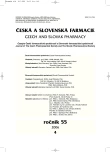-
Medical journals
- Career
Naphthoquinones – biosynthesis, occurrence and metabolism in plants
Authors: P. Babula 1; R. Mikelová 2; V. Adam 2; R. Kizek 2; L. Havel 3; Z. Sladký 1
Authors‘ workplace: Veterinární a farmaceutická univerzita Brno, Farmaceutická fakulta, Ústav přírodních léčiv 1; Mendelova zemědělská a lesnická univerzita v Brně, Agronomická fakulta, Ústav chemie a biochemie 2; Mendelova zemědělská a lesnická univerzita v Brně, Agronomická fakulta, Ústav biologie rostlin 3
Published in: Čes. slov. Farm., 2006; 55, 151-159
Category: Review Articles
Overview
Naphthoquinones are relatively widely occurring natural substances, products of secondary metabolism of some actinomycetes, fungi, lichens, and higher plants. The importance of these substances for the producers proper is, due to their wide biological activity, still discussed. In most cases they act as phytoalexines. In the case of fungi, they may play a significant role in the pathogenicity of moulds – naphthoquinones interact with mitochondria, microsomes and cytoplasmic proteins, in the form of radicals they are bound to DNA and RNA, and they do damage to them. Naphthoquinones are highly cytotoxic substances; their antimicrobial, antifungal, antiviral and antiparasitic effects have been observed. In traditional medicines, particularly in some parts of Asia (China) and South America, naphthoquinones–containing plants are widely used primarily in the treatment of various tumoral and parasitic diseases.
Key words:
plumbagin – juglone – vitamin K – shikimic acid – Drosera
Labels
Pharmacy Clinical pharmacology
Article was published inCzech and Slovak Pharmacy

2006 Issue 4-
All articles in this issue
- Naphthoquinones – biosynthesis, occurrence and metabolism in plants
- Angiotensin Converting Enzyme Inhibitors
- Protective Effects of the Flavonoids Osajin and Pomiferin on Heart Ischemia – Reperfusion
- Properties of Benzethonium Chloride in Micellar Solutions and the Effect of Added Sodium Chloride
- A Study of Qualitative Properties of the Essential Oil of Tanacetum vulgare L.
- Effect of AgNO₃ on the Production of Flavonoids by the Culture of Ononis arvensis L. in vitro
- Theory and Practice of Pharmacopoeial Control of the Quality of Drugs and Auxiliary Substances VI. Stability of Comparative Colour Solutions of the Czech Pharmacopoeia 2002
- Czech and Slovak Pharmacy
- Journal archive
- Current issue
- Online only
- About the journal
Most read in this issue- Angiotensin Converting Enzyme Inhibitors
- Naphthoquinones – biosynthesis, occurrence and metabolism in plants
- Properties of Benzethonium Chloride in Micellar Solutions and the Effect of Added Sodium Chloride
- Protective Effects of the Flavonoids Osajin and Pomiferin on Heart Ischemia – Reperfusion
Login#ADS_BOTTOM_SCRIPTS#Forgotten passwordEnter the email address that you registered with. We will send you instructions on how to set a new password.
- Career
